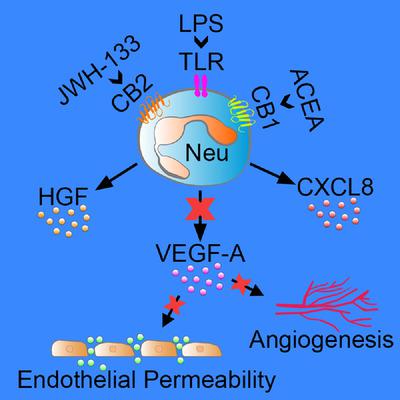当前位置:
X-MOL 学术
›
J. Leukoc. Biol.
›
论文详情
Our official English website, www.x-mol.net, welcomes your feedback! (Note: you will need to create a separate account there.)
LPS‐mediated neutrophil VEGF‐A release is modulated by cannabinoid receptor activation
Journal of Leukocyte Biology ( IF 5.5 ) Pub Date : 2020-06-23 , DOI: 10.1002/jlb.3a0520-187r Mariantonia Braile 1 , Leonardo Cristinziano 1 , Simone Marcella 1 , Gilda Varricchi 1, 2, 3 , Giancarlo Marone 4, 5 , Luca Modestino 1 , Anne Lise Ferrara 1 , Agnese De Ciuceis 1 , Sara Scala 1 , Maria Rosaria Galdiero 1, 2, 3 , Stefania Loffredo 1, 2, 3
Journal of Leukocyte Biology ( IF 5.5 ) Pub Date : 2020-06-23 , DOI: 10.1002/jlb.3a0520-187r Mariantonia Braile 1 , Leonardo Cristinziano 1 , Simone Marcella 1 , Gilda Varricchi 1, 2, 3 , Giancarlo Marone 4, 5 , Luca Modestino 1 , Anne Lise Ferrara 1 , Agnese De Ciuceis 1 , Sara Scala 1 , Maria Rosaria Galdiero 1, 2, 3 , Stefania Loffredo 1, 2, 3
Affiliation

|
Neutrophils (PMNs) are innate immune cells with primary roles in inflammation and in host defense against infections. Both inflammatory and tumor angiogenesis are modulated by a sequential, coordinated production of angiogenic factors such as vascular endothelial growth factors (VEGFs), angiopoietins, hepatocyte growth factor (HGF), and chemokines. These factors are produced by several immune cells, including PMNs. Activation of cannabinoid receptor type‐1 (CB1) and ‐2 (CB2) has been suggested as a new strategy to modulate in vitro and in vivo angiogenesis. We sought to investigate whether activation of CB1 and CB2 by CB agonists modulate LPS‐mediated angiogenic activity of human PMNs. Highly purified PMNs were isolated from buffy coats of healthy donors. Cells were stimulated with CB1 and CB2 agonists/antagonists alone and/or in combination with LPS. Angiogenic factors in cell‐free supernatants were measured by ELISA. The modulation of activation markers of PMNs by CB agonists was evaluated by flow cytometry. Angiogenesis in vitro was measured as tube formation by optical microscopy. Endothelial cell permeability was assessed by an in vitro vascular permeability assay. LPS‐activated PMNs released VEGF‐A, CXCL8, and HGF. Preincubation of PMNs with low concentrations of CB1 and CB2 agonists inhibited VEGF‐A release induced by LPS, but did not affect CXCL8 and HGF production. The effects of CB agonists on VEGF‐A release induced by LPS were reversed by preincubation with CB antagonists. CB agonists modulated in vitro angiogenesis and endothelial permeability induced by supernatants of LPS‐activated PMNs through the reduction of VEGF‐A. Neutrophils play a central role in the control of bacterial infections and in the outcome of sepsis. The latter condition is associated with an increase in circulating levels of VEGF‐A. We demonstrated that low concentrations of CB agonists inhibit VEGF‐A release from LPS‐activated PMNs. These results suggest that CB agonists might represent a novel therapeutic strategy in patients with sepsis.
中文翻译:

LPS介导的中性粒细胞VEGF-A的释放受大麻素受体激活的调节
中性粒细胞(PMN)是先天性免疫细胞,在炎症和宿主抵抗感染中起主要作用。炎症和肿瘤血管生成均受血管生成因子(例如血管内皮生长因子(VEGF),血管生成素,肝细胞生长因子(HGF)和趋化因子)的顺序协调产生的调节。这些因素是由包括PMN在内的几种免疫细胞产生的。有人提议激活1型(CB 1)和2型(CB 2)大麻素受体是激活体外和体内血管生成的新策略。我们试图调查是否激活了CB 1和CB 2CB激动剂的作用是调节LPS介导的人类PMN的血管生成活性。从健康供体的血沉棕黄层中分离出高度纯化的PMN。单独和/或与LPS组合用CB 1和CB 2激动剂/拮抗剂刺激细胞。通过ELISA测定无细胞上清液中的血管生成因子。通过流式细胞术评估了CB激动剂对PMNs激活标记的调节。体外血管生成通过光学显微镜测量为管形成。内皮细胞通透性通过体外血管通透性测定来评估。LPS激活的PMN释放VEGF-A,CXCL8和HGF。低浓度CB 1和CB 2的PMN的预培养激动剂抑制LPS诱导的VEGF-A释放,但不影响CXCL8和HGF的产生。通过与CB拮抗剂预孵育可以逆转CB激动剂对LPS诱导的VEGF-A释放的影响。CB激动剂通过降低VEGF-A来调节LPS激活的PMN上清液诱导的体外血管生成和内皮通透性。中性粒细胞在控制细菌感染和败血症的结果中起着核心作用。后一种情况与循环中的VEGF-A水平升高有关。我们证明了低浓度的CB激动剂会抑制LPS激活的PMNs释放VEGF-A。这些结果表明,CB激动剂可能代表败血症患者的一种新型治疗策略。
更新日期:2020-06-23
中文翻译:

LPS介导的中性粒细胞VEGF-A的释放受大麻素受体激活的调节
中性粒细胞(PMN)是先天性免疫细胞,在炎症和宿主抵抗感染中起主要作用。炎症和肿瘤血管生成均受血管生成因子(例如血管内皮生长因子(VEGF),血管生成素,肝细胞生长因子(HGF)和趋化因子)的顺序协调产生的调节。这些因素是由包括PMN在内的几种免疫细胞产生的。有人提议激活1型(CB 1)和2型(CB 2)大麻素受体是激活体外和体内血管生成的新策略。我们试图调查是否激活了CB 1和CB 2CB激动剂的作用是调节LPS介导的人类PMN的血管生成活性。从健康供体的血沉棕黄层中分离出高度纯化的PMN。单独和/或与LPS组合用CB 1和CB 2激动剂/拮抗剂刺激细胞。通过ELISA测定无细胞上清液中的血管生成因子。通过流式细胞术评估了CB激动剂对PMNs激活标记的调节。体外血管生成通过光学显微镜测量为管形成。内皮细胞通透性通过体外血管通透性测定来评估。LPS激活的PMN释放VEGF-A,CXCL8和HGF。低浓度CB 1和CB 2的PMN的预培养激动剂抑制LPS诱导的VEGF-A释放,但不影响CXCL8和HGF的产生。通过与CB拮抗剂预孵育可以逆转CB激动剂对LPS诱导的VEGF-A释放的影响。CB激动剂通过降低VEGF-A来调节LPS激活的PMN上清液诱导的体外血管生成和内皮通透性。中性粒细胞在控制细菌感染和败血症的结果中起着核心作用。后一种情况与循环中的VEGF-A水平升高有关。我们证明了低浓度的CB激动剂会抑制LPS激活的PMNs释放VEGF-A。这些结果表明,CB激动剂可能代表败血症患者的一种新型治疗策略。

























 京公网安备 11010802027423号
京公网安备 11010802027423号